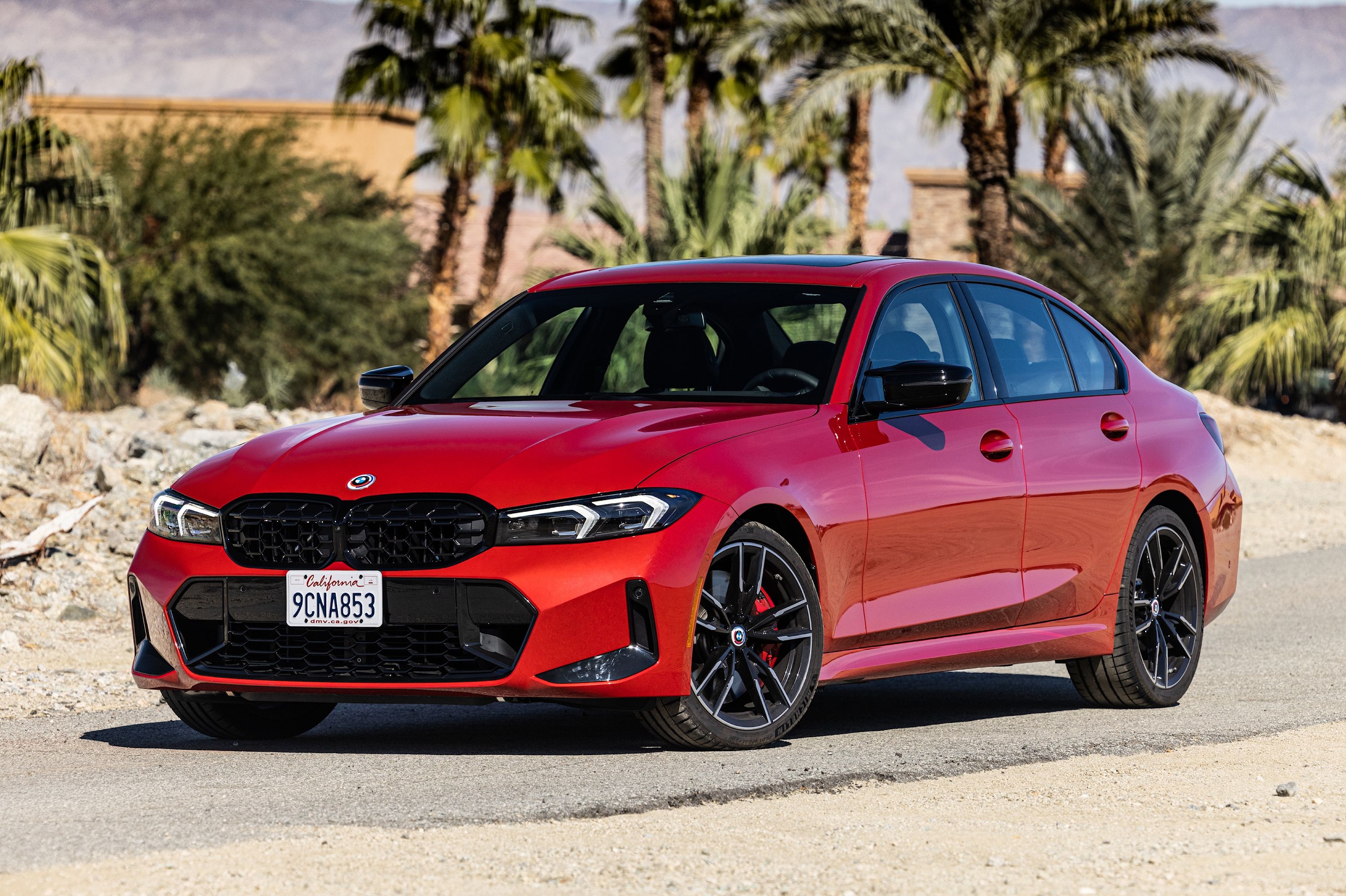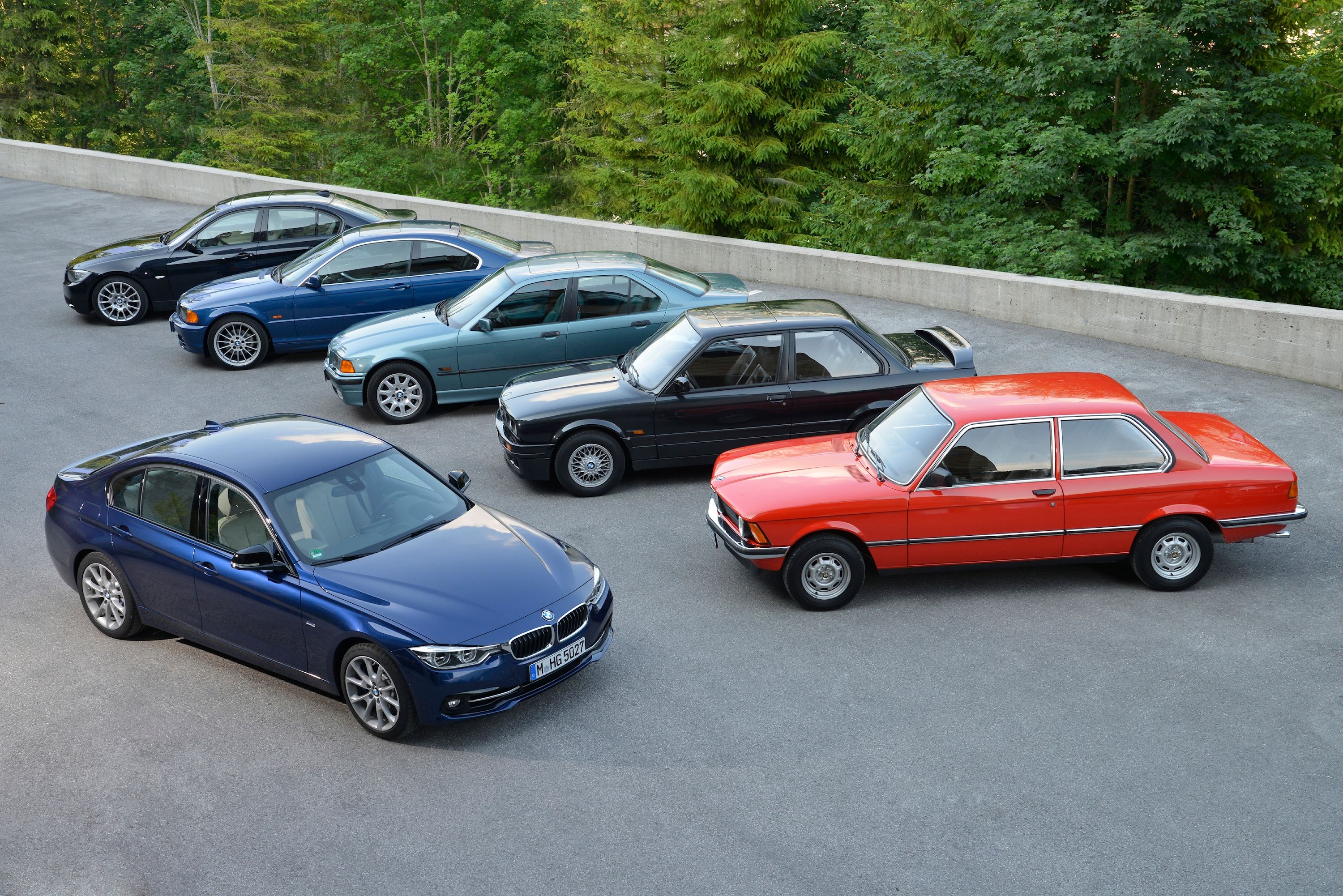
Forget the crossovers and EVs - the BMW 3 Series sedan is still the brand's quintessential model, representing relatively accessible luxury transportation from a premium company. It blends practicality, prestige, and a fun-to-drive nature admirably. But while the '3 Series' moniker is as legendary as 'GTI' or '911', not every generation of BMW's compact luxury sedan has been as universally adored or impactful as the next. The seventh-generation G20 may outclass the E30 in every possible metric, but is it a more revered car? Most would say no. To that end, we present you with a ranking of every BMW 3 Series generation from best to worst.
1. E46 (1997-2006)
The E46 was a sensational sweet spot in the history of the 3 Series and was built between 1997 and 2006. It retained fairly compact proportions and a driver-focused appeal, yet added technology and comforts that made it easier to live with than the E36. A CAN bus electronics system, satellite navigation, the return of an available all-wheel drivetrain, and rain-sensing wipers were among the new introductions that came with the E46. But these features pale in comparison to the driving experience.
The body shell was around 70% more rigid than the E36's one. It not only drove comfortably but the hydraulic steering rack was far more organic in its sensations than the latest electronic systems. The steering was heavier than many other luxury cars, but the upside was a clear sense of what the front wheels were up to. Producing between 105 and 360 horsepower depending on the engine and market, US-spec E46s were highlighted by several beautifully smooth inline-sixes. They needed to be pushed hard to provide potent performance, but that's something these engines embraced fully.
By the time 2005 rolled around, the E46 lineup consisted of 325i and 330i models, both available with AWD. Back then, the badge on the back still had something to do with the engine size. The latter produced 225 hp and 214 lb-ft of torque and was available with a sweet-shifting manual gearbox. Of course, the E46 M3 is one of the most brilliant sports coupes ever made, and the flawed but brilliant M3 CSL was a true Porsche rival on the track.
The E46 wasn't perfect, of course. Cooling systems that used brittle plastic components, failing seals for the VANOS variable valve timing system, and lower control arms that went bad after around 80,000 miles were some of the most common complaints. But when everything was working, the E46 BMW 3 Series was a deeply talented car. That's why over 3.2 million of them were sold around the world, making this the top-selling BMW model ever. The design has also aged superbly.
2. E30 (1982-1994)
It was this, the second-generation BMW 3 Series, that really entrenched BMW's reputation for building compact luxury sedans that were enjoyable to drive. Depending on the market and powertrain, the E30 produced between 90 and 238 hp. Of course, this was the first 3 Series to spawn a high-performance M3 variant which made it possible for BMW to compete in the German Touring Car Championship (DTM).
The E30's clean lines have aged remarkably well, and North American models were distinguished by protruding aluminum bumpers initially. The 325iX was the first 3 Series with AWD, but the US also got lower-powered 318i models.
Notably, the new suspension with MacPherson struts in front and a rear semi-trailing arm allowed for more interior space. The car was prone to bump steer under hard cornering, but its otherwise composed handling was generally praised. YouTube has no shortage of videos of E30 3 Series models having their rear tires being absolutely destroyed while doing one donut after another. We wouldn't want to treat an old E30 like that today, but the car encouraged such behavior.
Today, well-preserved examples of the E30 have dramatically increased in value. It wasn't long ago that a 1988 M3 sold for $250,000, over three times the price of a brand-new M3 in 2022.
3. E36 (1990-2000)
Stylistically, the E36 was a rather dramatic departure from the boxy E30. BMW says the design language was a lot more coupe-oriented, with A- and C-lines that were more strongly sloped than before. The twin headlamps remained but they now sat beneath a glass cover for a more streamlined look.
Unlike the E30 and E46, the E36 was exclusively available with RWD; there was no AWD alternative. In the US market, the E36 sedan was available in 318i and 325i variants initially. The US-spec M3 made only 240 hp as opposed to as much as 321 hp in other markets, but its six-cylinder engine was a marked step up from the E30 M3's four-pot.
At around 500 pounds heavier than the E30, the E36 packed in far more luxury and extra sound-deadening material. A new Z-axle multilink rear suspension was another vast improvement, although the oddball E36 3 Series Compact hatchback retained a rear semi-trailing arm suspension. More powerful E36s were hugely fun to drive and manual gearboxes were still common enough. By comparison, the W202 Mercedes-Benz C-Class of the time felt distinctly conservative.
Although the interior was a lot plusher and more modern, many believe that the E30 was a more solid car overall and one which could take more abuse. The E36 could also reach high mileages but required a more meticulous preventative maintenance schedule. Like the E46, water pump and radiator issues were commonplace.
4. G20 (2018-present)
Compared with the E30, the current G20 3 Series is a tank. It's over 10 inches longer, around seven inches wider, and starts at about 1,000 lbs more. That it's still described as a "compact" luxury sedan seems like a bit of a misnomer. All that being said, the G20 is a bit of a return to form for the 3 Series after the underwhelming F30. It handles about as sweetly as anything else in the segment, yet is more spacious than ever before. Body rigidity increased by about 50% yet it's over 100 lbs lighter than its predecessor. The ride quality is too firm on some models, though, which wasn't an issue on older 3 Series models.
Sadly, there is no manual gearbox in non-M3 models and you'll need to spend at least $54,700 on an M340i to get a six-cylinder engine. However, even the base 330i's four-pot is surprisingly smooth and provides excellent performance.
With the E90 (which you'll find lower down on this list), some of the technology introduced appeared before BMW could refine it. Years later, the G20 feels like it takes less time to figure out, despite it having the most advanced roster of features.
Some of the magic of the older 3 Series models may have been lost as BMW discarded some of its sporting genes in the pursuit of luxury, but the G20 is an exceptionally complete package.
5. E90 (2005-2013)
Replacing the universally loved E46 was never going to be easy and the E90 had a lukewarm reception from some quarters, despite continuing to sell strongly. The fifth-generation 3 Series suffered from more modern but awkward styling, an earlier - and more cumbersome - version of the iDrive infotainment system, and run-flat tires that spoiled the ride on some models. Still, the E90 was named the World Car of the Year in 2006.
The E90 was the last 3 Series to come with naturally-aspirated engines. It did, however, introduce the twin-turbocharged N54 inline-six in 335i models.
This N54 won five straight International Engine of the Year awards but reliability was not its strong suit, with a host of high-pressure fuel pump failures in the United States that led to a class-action lawsuit. The 325i (215 hp/185 lb-ft) and 330i (255 hp/220 lb-ft) models were more reliable.
The E90 gripped harder than its predecessor and rolled less through the corners, had a more roomy and luxurious cabin, and was faster in most instances. This generation of the 3 Series saw the launch of the only series-production V8-engined M3 (the E46 M3 GTR wasn't series production), a phenomenal car that made 414 hp and could reach 60 mph in as little as 4.5 seconds. But while the E90 looked great on paper, it simply wasn't as desirable as the E46 before it. Of course, that didn't stop BMW from selling over 3 million of them.
6. E21 (1975-1983)
The first-generation 3 Series may not be impressive by today's standards, but it set the tone for what would become one of the most iconic model lines in history when it replaced the 02 Series. Base models made a mere 75 hp in other markets but the two-door body style with the distinctive shark nose showed how much BMW prioritized performance and style over anything else, even back then. It was this car that introduced the angled dashboard that became a signature of BMWs for decades to come and the Hofmeister kink C-pillar continues to live on today.
In North America, the E21 was sold from 1977 to 1983. Six-cylinder models were not available in America due to emissions regulations in place at that time, and the 320i four-cylinder models sold here didn't make much more than 100 hp. Although dynamically accomplished, the E21 was known for a disturbing snap oversteer issue that was caused by the semi-trailing arm type independent suspension at the back.
Considering the design elements that have become intrinsically associated with the brand and the establishment of what would become a burgeoning market segment in the years to come, the E21 remains an absolute classic. It's estimated that over 1.3 million examples were produced.
7. F30 (2011-2019)
Is the sixth-generation F30 BMW 3 Series a bad car? Not by a long shot. So, why is it last on this list? In our opinion, the F30 strayed furthest from the original 3 Series ethos of being a dynamically sharp, engaging, and well-balanced sedan that could do it all. It didn't help that naturally-aspirated engines were completely cut from the 3 Series range for the first time or that electric power steering replaced the more feelsome hydraulic system used before. As a result, it lacked the driver engagement of the E90 before it and certainly any 3 Series before that. It was comfortable and sharp enough, but that playfulness inherent in every other 3 Series before was missing. The smart exterior design was hard to fault, however.
Inside, there were more problems. Although once again more spacious and packed with features, the F30 had a humdrum cabin design and too many hard, cheap plastics, especially on base models. Both the Audi A4 and Mercedes-Benz C-Class sold at the time looked and felt a lot more upscale.
This generation of the 3 Series ushered in a turbocharged M3 for the first time; the old M3 Coupe was rebadged as the M4. Producing 425 hp and 406 lb-ft, the M3 was immensely powerful but the engine was peaky and the ride unacceptably brittle on early models. The analog feel of earlier M3s was gone, replaced by a faster car but one that felt overly computerized. Subsequent Competition versions improved matters, but this is not anywhere close to being the best M3.
The F30 was a solid family sedan and BMW sold over 2.6 million of them, but it remains the least impactful 3 Series, which is why it's last on this list.

